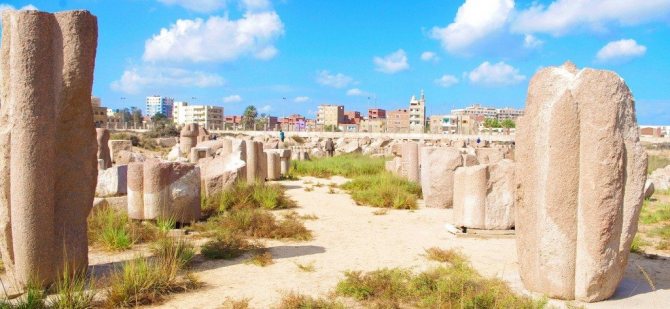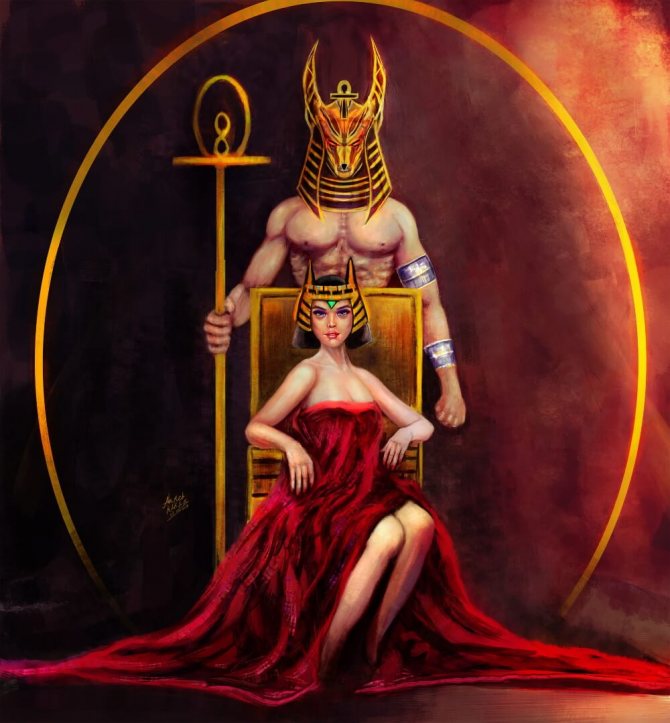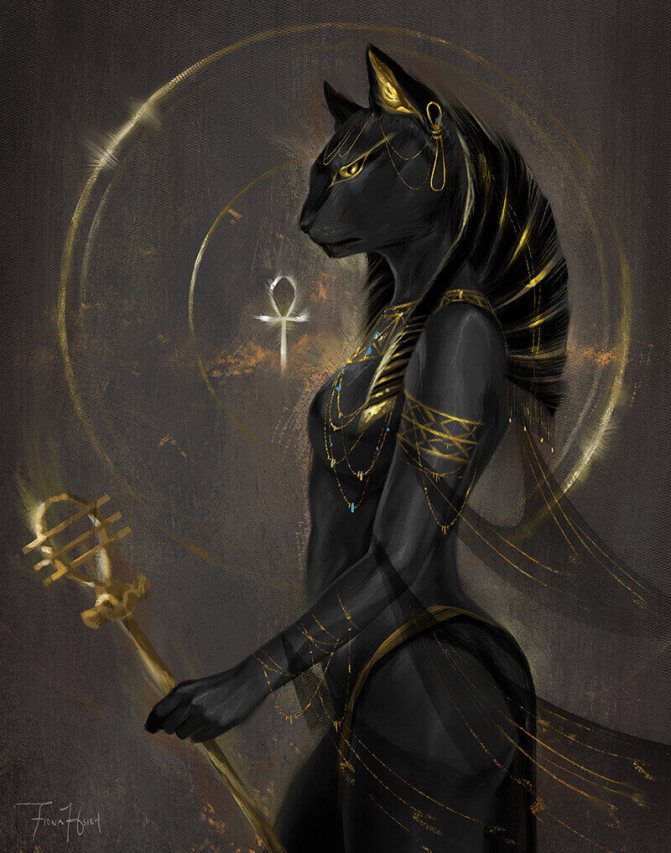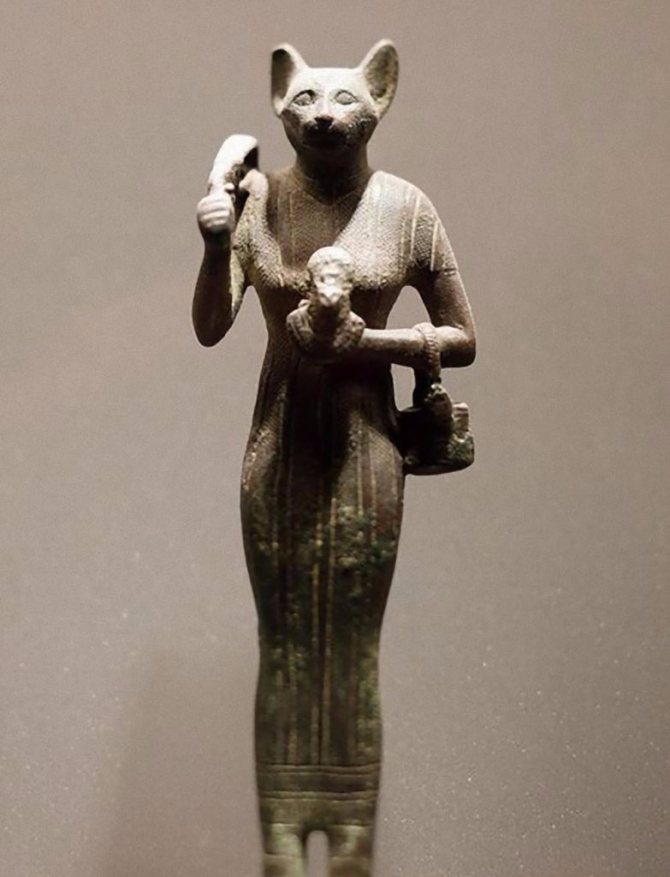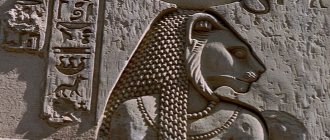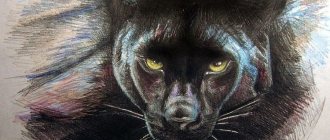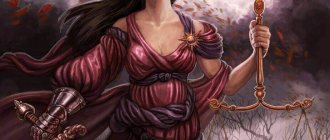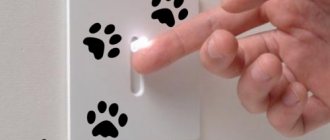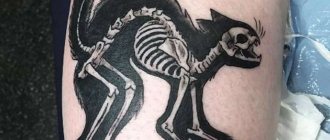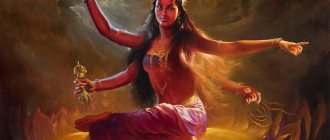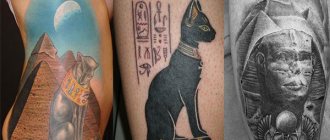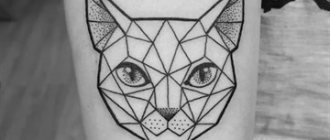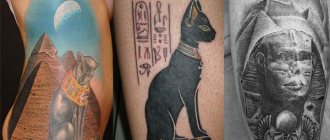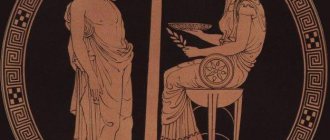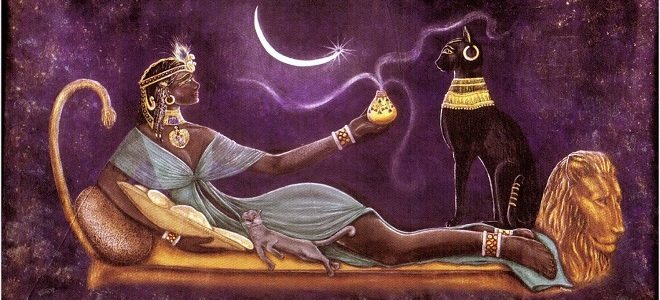
The embodiment of light, joy, rich harvests, love and beauty in ancient Egypt was the divine woman Bastet. She was called the mother of all cats, worshipped as the guardian of home, comfort and family happiness. The Egyptian myths always described the image of the woman differently: she was graceful and tender, then aggressive and vengeful. Who was the Goddess in fact?
The origin of .
From ancient Egyptian myths, it follows that the father of Bastet was the sun god Ra. However, there are other versions as well. For example, in some regions it was believed that Bastet was the daughter of Osiris and Isis. This seems to be due to the fact that the development of Egyptian theology followed the path of replacing one deity with another. Thus Osiris, originally the god of fertility, eventually became the judge of the afterlife, a function that Ra had once fulfilled. Bastet's husband was at one time considered to be the dwarf Bes, the giver of joy, the patron saint of old men and children.
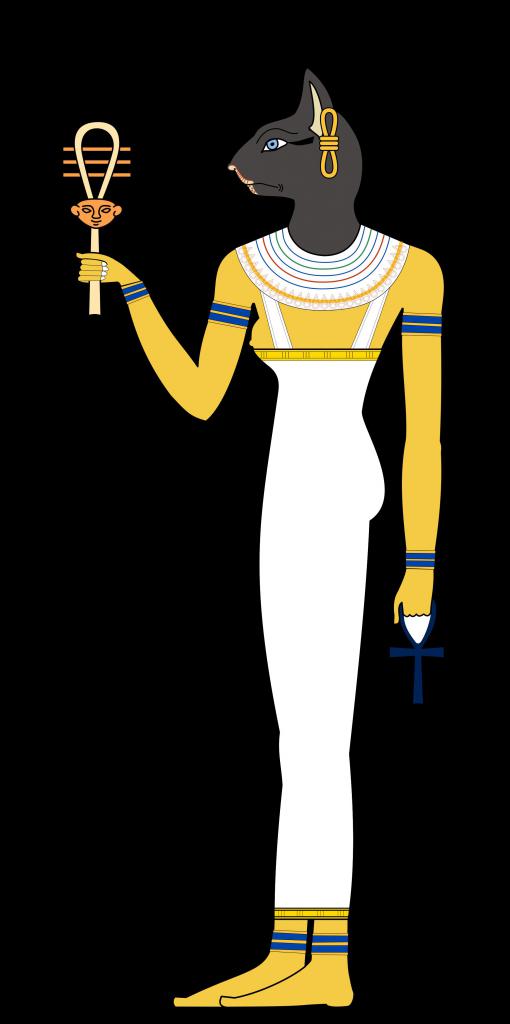

It should be noted that sometimes another variant of the name of this Egyptian goddess is found in literature. Bastet is an artificially created name, as the exact pronunciation of the Egyptian hieroglyphs is unknown. As the vowels were not displayed in the writing, the pronunciation of the name could look like "Bast". Both variants are equals.
Functions of the goddess
The cult of Bastet was formed even before the cat was domesticated, and in those days she was associated more with the lioness. But gradually, when the usefulness of cats (they hunted mice in temple barns and thus not only protected grain from spoilage, but also prevented the spread of plague) turned into their veneration, more attractive features appeared in the image of the ancient Egyptian goddess Bastet.
First, she was the patroness of women and procreation. It was Bastet who offered prayers to those who could not become pregnant. Gradually the goddess came to be perceived as the patroness of fertility in principle. The second function of Bastet was to heal. Egyptian doctors often painted a black cat on the doors of a sick person's home, which was believed to bring healing. This image could also be used for "preventive" purposes.
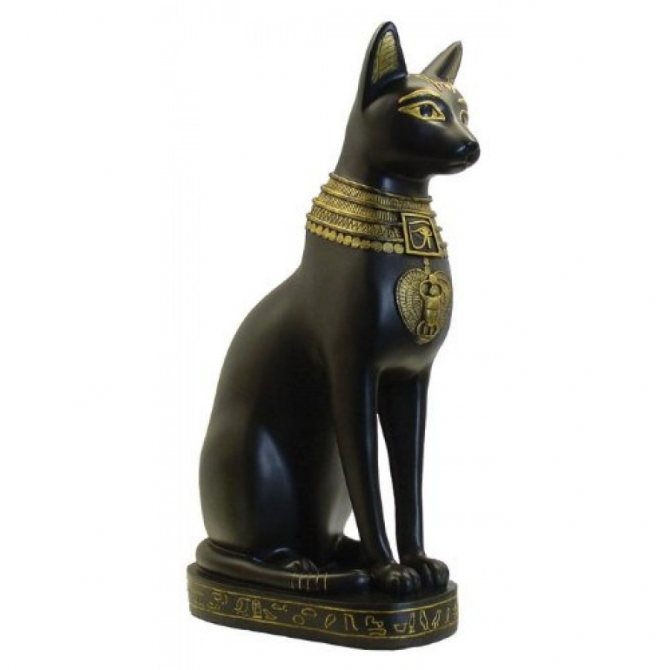

From the patronage of women in general, another function of Bastet gradually stood out. It was believed that by her will she could stop aging and help women retain their beauty. The priests of Bastet even developed a whole complex of physical exercises. It was believed that when they were performed, the goddess inhabits a woman's body and allows her to remain not only attractive but also graceful.
The goddess Bastet - interesting facts
We have reached us very interesting facts about the goddess Bastet:
- The cult center of veneration of the Goddess was the city of Bubastis. A temple was erected in the center of it, which housed her largest statue and the tombs of cats.
- The symbolic color of the Goddess Bastet is black. It is the color of mystery, night and darkness.
- The feast of veneration of the Goddess was celebrated on April 15. On that day the people rejoiced and partied, and the main event of the celebration was a beautiful ceremony on the banks of the Nile. The priests loaded her statue into a boat and sent her down the river.
- Bastet, the patroness of women and their beauty, was regarded by girls as the ideal of femininity. The same brightly outlined arrows around the eyes began to be drawn by Egyptian women to become like their patroness.
- The cat goddess Bastet ceased to be worshipped when the Romans came to power. In the 4th century BC, the new ruler forbade her worship and cats, especially black cats, began to be widespread exterminated.
Appearance
What the goddess Bastet looks like is evidenced by the numerous images left on the walls of surviving tombs and temples. Thanks to this we can trace the evolution of the image of the goddess.
Initially she was associated with a lioness. In later periods, Bastet is depicted as an anthropomorphic cat or a woman with a cat's head. Four small kittens were sometimes depicted next to her, which symbolized the patronage of procreation.
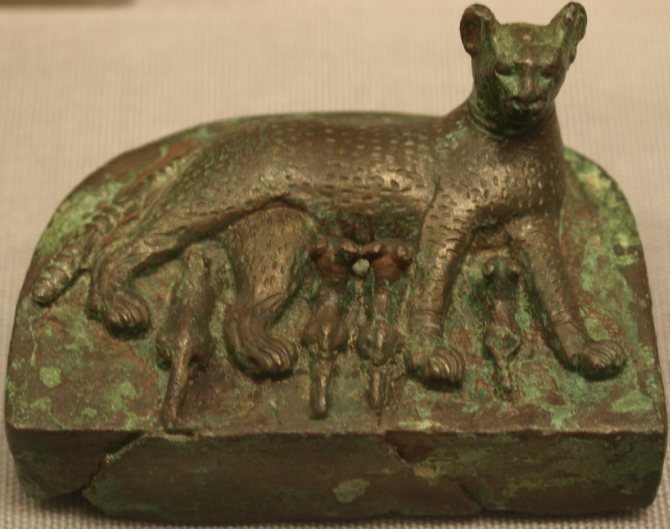

Bastet sometimes clutched a sistrum in her hands. This percussive musical instrument was used in services dedicated to Isis. This shows the close relationship between the two goddesses, whom later mythology turned into mother and daughter. It is noteworthy that sometimes the sistrum was in the hands of Hathor, the goddess of love and beauty. In the later stage of the development of ancient Egyptian mythology, both goddesses performed similar functions.
About Beauty
As in all times, women were looking for ways to preserve their youth. And in this they were perfectly helped by the goddess of Egypt Bastet. The priests created a certain number of exercises for women, which, in their opinion, should have stopped the fading beauty of the lady. While doing them, it was believed that the spirit of Bastet was instilled in a woman, which awakened her gracefulness, plasticity, and hidden strength of spirit. After these exercises Egyptian women believed that they would remain attractive and young for a long time.
Bastet and Sekhmet.
In polytheistic religions the gods very often had many hypostases, especially in Ancient Egypt, which was prone to mysticism. The description of the goddess Bastet would be incomplete without mentioning her aggressive incarnation, Sekhmet.
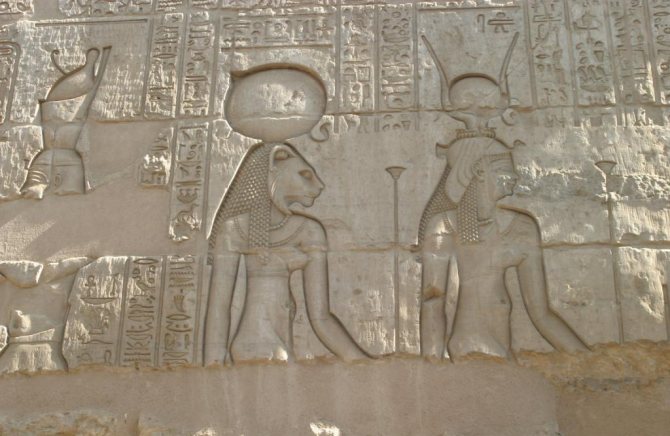

When in the period preceding Ehnaton's religious reform the Egyptian priests tried to somehow order the cult and distinguish the functions of the gods, they encountered a number of serious problems, including the question of whether Bastet and Sekhmet were different goddesses or whether they were still two different incarnations. Since Bastet was increasingly associated with the family hearth and beauty, it was decided that Sekhmet was an independent deity. But since a certain aggressiveness in the image of Bastet was still preserved, she was given another name - Pasht (Pusht).
It is unlikely that this was actually the case. As already mentioned, it was the goddess Bastet in Egypt of the Ancient Kingdom period who was depicted with the head of a lioness. And the myths said that once the gods were angry with people and decided to wipe the entire human race off the face of the earth. The gods were entrusted to Bastet, who, taking the image of Sekhmet, descended to the earth and wreaked such havoc that the earth was blackened with blood. The gods, who were terrified, realized that they had been overzealous both in destroying the people and in choosing the instrument of vengeance. They tried to subdue Bastet-Sekhmet, but failed. Only cunning saved the survivors from destruction. The gods poured tinted beer (according to another version, wine) over the ground, and Bastet-Sekhmet, mistaking the drink for blood, drank it all and fell asleep. That was enough time to carry the enraged goddess away and calm her down.
The appearance of Bastet in mythology
In fact, there is very little information about the appearance of Bastet in Egyptian mythology. It is reliably known that her father is the supreme god Ra, and her mother is the goddess Hathor. In fact, Bastet is the daughter of the sun and the moon at the same time. Nevertheless, Bastet was one of the most revered goddesses in ancient Egypt, and the popularity of her cult was not inferior to that of Amon-Ra. At least until the unification of Egypt and giving the cult of Amon-Ra the status of a state religion.
Anton
Ask a question
Question to an Expert
Why are Bastet and Sekhmet considered the same character?
Before the unification of the country into one, people in lower Egypt worshipped Ra's daughter, named Bast, and in Upper Egypt, worshipped Sekhmet. After the unification of the country, however, the cult of worship merged together, and with it, the images of the goddesses.
However, there is still disagreement about who Bastet actually was. She was believed to be the spiritual embodiment of the goddess Isis. However, Bastet was responsible for many branches in ancient Egypt. She was the goddess of joy, fun and love, the goddess of fertility. But she was especially worshipped by women because Bastet was also the goddess of hearth and home, the goddess of woman's beauty and the goddess of childbirth.
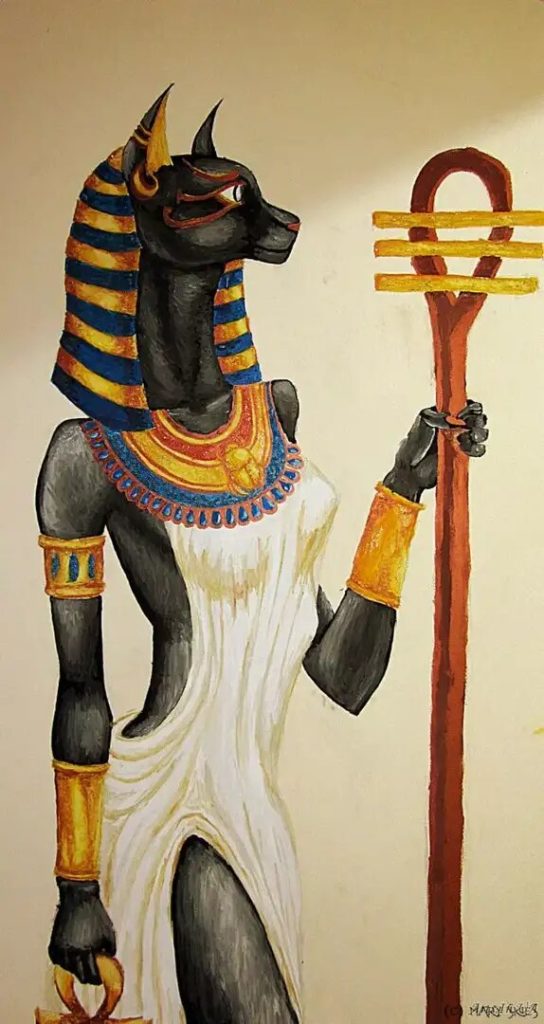

However, historians agree that Bastet was especially popular because she was the goddess of cats. Perhaps no one needs to be reminded of how sacred cats were in ancient Egypt. What to say, if a driver who accidentally ran over a cat was stoned to death. And it was strictly forbidden to take these animals out of the country.
Cats were considered sacred animals in Egypt long before the popularization of the cult of Bastet. Initially, cats were highly prized as fighters against snakes and mice. This may not be the main reason for the popularization of these animals, but it is certainly one of them.
Not surprisingly, Bastet was depicted as a creature with a human body and a cat's head. Moreover, she was also depicted completely in the body of a cat, but only in a sitting position. In the standing position, she remained half-human. It is noteworthy that Bast had a second, more formidable appearance. The ancient Egyptians considered a lion a symbol of strength and protection. So it is not surprising that the second, formidable and warlike appearance of Bastet was Sekhmet, a creature with a female body and a lion's head.
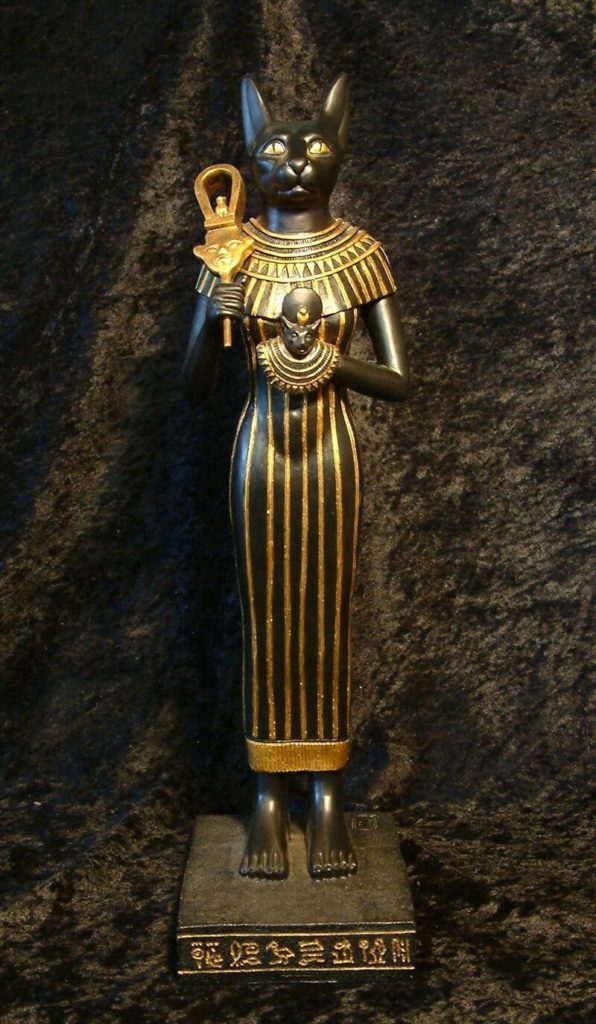

It is worth noting that Bast and Sekhmet were originally considered different characters. However, in times of fusion of Upper and Lower Egypt, the cult of goddesses was united. And even before that they were depicted quite identically, with the same attributes and symbols of power, as a result of which the cult of Bastet united the goddesses into two opposing entities of one whole. In addition, in late Egyptian times, Bastet also merged with Isis.
Despite the fact that almost all sources indicate that Bast loved the color black (as evidenced by her love of black cats, as well as their popularity in those times), the goddess preferred to dress in green robes. As always, in the images of the time, the goddess's clothing was as open as possible.
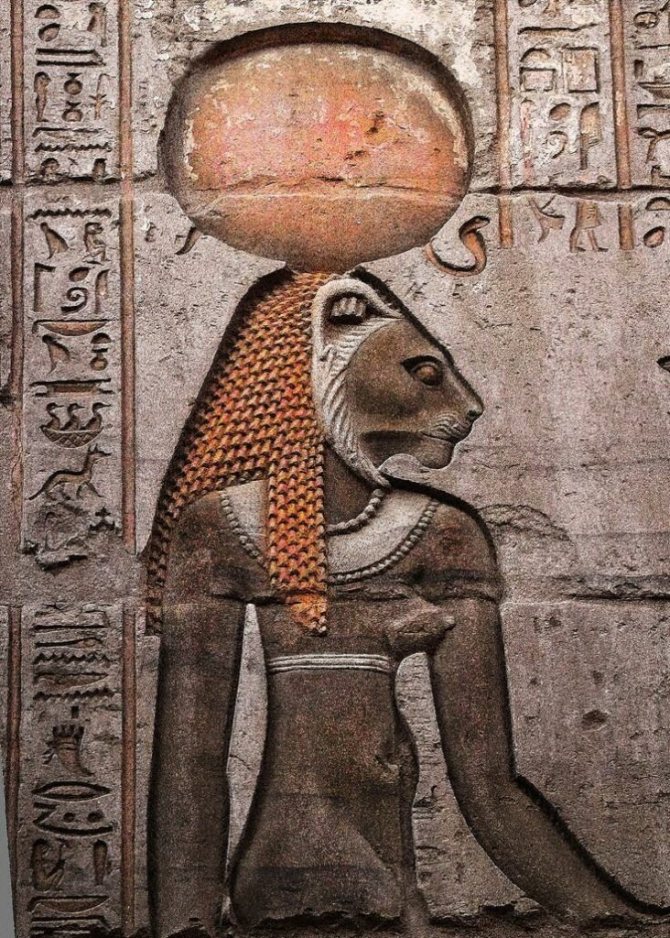

The heyday of the cult
As already mentioned, the deification of cats was related to their extermination of rodents. This problem was especially urgent during the Middle Kingdom, when huge barns were erected at the temples. Around the same time, cats became increasingly domesticated, leading to the gradual pushing of the lion cult into the background.
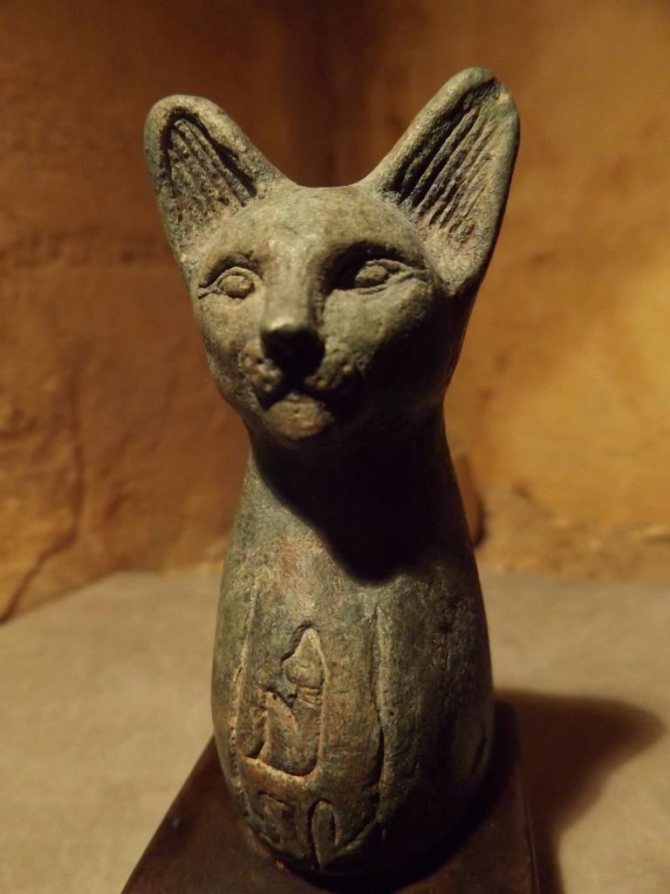

The veneration of cats in ancient Egypt was as strong as that of cows in ancient India. There were occasions that would seem strange to modern man. For example, if there was a fire, the first thing they did was rescue the cat and only then the children.
Eugenie McQueen
A cat is valued for being a cat. A mongoose is valued for what it does.
The oldest saying about a cat. Ancient Sumer.
The homeland of modern cats living close to humans has its roots in Mesopotamia, Anatolia and Egypt, although their common ancestor lived more than 100,000 years ago.
And man's friendship with these amazing animals began about 12,000 to 10,000 years ago, when people switched to a sedentary lifestyle and began to grow cereals.
The first human burial with his pet cat was found in Cyprus and was carried out about 9500-9200 years ago. Archaeologists have even determined the cat's age, eight months, but could not find out the sex. 8,700 years ago there are traces of cat domestication in Jericho.
About 6,000 years ago, cats appear near human settlements in what is now Bulgaria, 5,000 years ago in Romania and Ukraine (Trypilian culture), and then 3,000 years ago in Greece.
At first, it was a mutually beneficial symbiosis. Cats hunted rodents, which were attracted by the harvest of crops. That later made them a symbol of wealth and fertility among farmers. And by destroying rat carriers of terrible diseases such as the plague, cats became protectors of health and healers.
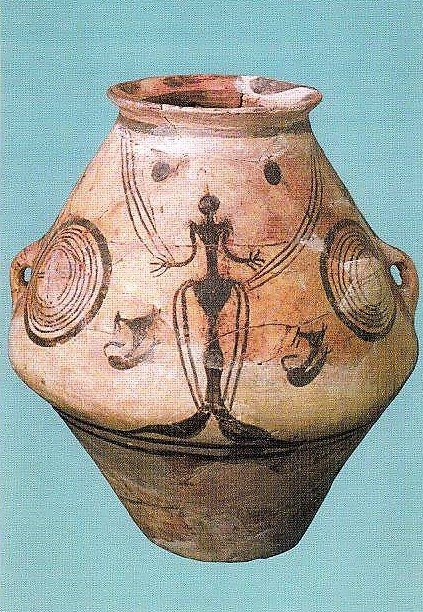

To this day, scientists still debate when cats became domesticated. And although with 2300 BC their images next to people are part of Egyptian art, but whether they were cats already living in the house or still wild, it is difficult to say.
Researchers from University College London believe that the real domestic cats become only during the New Kingdom in the 16-11 century BC.
But for the first time the cat appears in the records of the second dynasty (2847-2622 BC), which describe its gentle disposition and protective qualities. In the texts of the pyramids of the ancient kingdom, it is noted as the king's nurse (babysitter). Here the Egyptians especially noted her ability to care for their little ones.
One of the first Egyptian images of cats dates back to 2300 BC. This small stele is in the Vatican Museum. But look how well it captures the grace of the predator.
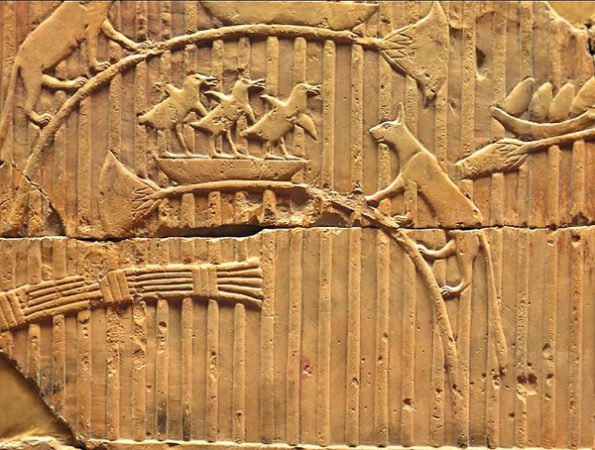

The roots of cat totem worship can be traced back to the first dynasties of Egypt, where she was still called Mafdet and originally had the formidable appearance of a lioness. The ancient kingdom knew her by that name and endowed her with epithets: Snake Killer, Lady of the Castle of Life, She Who Runs Fast, Royal Avenger, Big Cat. She was described as the warrior goddess of sunset, death, rebirth and wisdom. Her name can be found in spells against the deadly poisons and poisonous animals that abound in the hot desert of Kemt country.
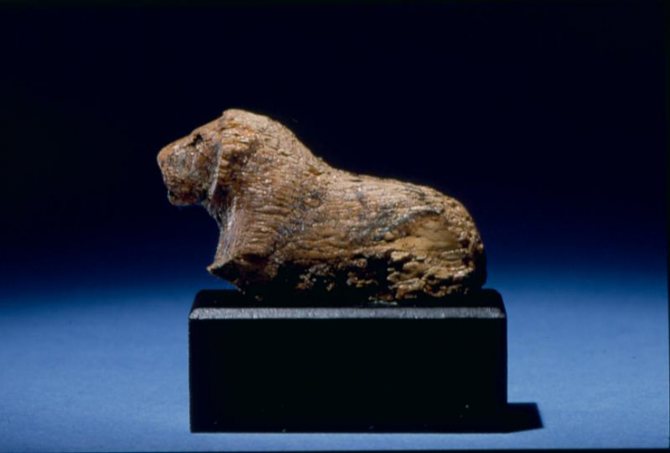

The goddess protected the sun god Ra from the bites of scorpions and snakes, killing them with the touch of her claws in the Underworld Duat. Her claws were harpoon points that protected the royal wayfarer sailing through the dangerous waters, wishing to reach happily Duat or get on the Boat of a Million Years. Therefore Mafdet was connected with the funeral rites of the pharaoh.
Justice and punishment for what had been done were the domain of the Goddess in the heavenly and earthly worlds.
But the Ancient Kingdom ends with the reign of Queen Neytikert. A terrible drought, climate change, and famine plunge the country into chaos for 200 years.
The Middle Kingdom bursts onto the scene of history. And Mafdet dissolves in the guises of Sekhmet, Tefnut, and Bast as guardians of lower Egypt and the pharaoh.
During the Middle Kingdom period ( 2000-1300 B.C.) cats already appear in records, where they are called miu or miut. miu and miuit, which means cat or "one who meows".
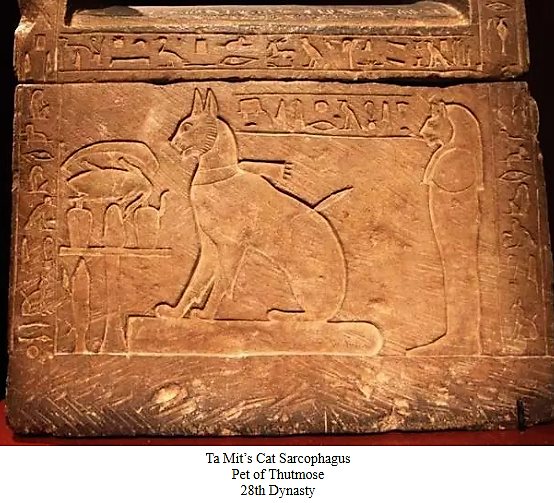

The most famous of our time was a cat with the personal name Ta-miu, that is "family cat", "the cat of our family" or "the venerable that cat" (according to Solkin), whose name is recorded on the sarcophagus of Prince Thutmose.
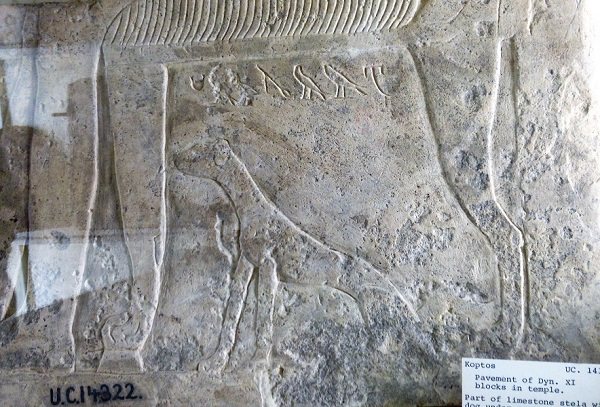

But cats were part of life not only of the royal family. This is evidenced by the ostracons (sketches on clay tiles) of the artisan city of El-Medina. Which humorously depict the attitude to the cat and confirm that it shared the world of ordinary toilers.
According to some versions, as the goddess of the name Bast, a cat appeared somewhere between the third and second millennium BC. But some believe that it takes such a peaceful form only by the middle of the second millennium, or even later. It is not reliably known what her name means. The spelling of her name includes the oil vessel, the sign of a woman and a goddess. When Egyptologists try to do a translation of the hieroglyphs, they get the phrase "oiling vessel." According to Solkin's version, "The one from the vessel of the divine fragrance." Knowing how important ointments and lappings were, especially in the cult of the departed, Bast was clearly associated with the other world and helped in the transition.
The appearance of the epithet "my kitty" and "my kitty" can probably also be attributed to this period. After all, a woman in ancient Egypt could be called Ta-miit (Cat) and a man Pa-mii (Cat).
The Egyptians may have been the first to compare her to a woman. There is a saying that has come down to us: "A man who smells myrrh, his wife is like a cat in his presence. The man who is stressed, his wife becomes a lioness in his presence. (Onchsheshonqy 15/11-12).
And since that time, the female sex has often been compared to a cat. Apparently such wonderful qualities as flexibility, strength, self-sufficiency, survivability, gentleness, fertility originally inherent in this amazing creature were also very important to women of the ancient world. But the aspect of fickleness, the ability to go from profoundly peaceful in case of danger to sharply moving to protection is also associated with the feminine and feline character.
The Egyptian tradition was the most striking example of cat worship. Although this did not exclude the sacrifice of thousands of cats followed by mummification. To understand the extent of cat worship and respectful burial, it is enough to remember that the British in the 19th century, when they were exporting many valuables from Egypt, also shipped 180 tons of mummified cat remains from the sacred necropolis of Bubastis, which were then recycled and scattered as fertilizer in the fields around Liverpool.
Behind the veneration of Bast and the cats was real life, in which the graceful creatures protected their owners from poisonous snakes and scorpions that crept into people's homes. And their purring brought healing and peace.
The cat, which the Egyptians believed had 28 kittens in its life, became associated with the lunar cycle and the magic of the moon.
She was also associated with the five feminine principles: gracefulness, fertility, fragrance, sexuality and beauty.
The goddess Bast loves music, art, and dance. She is presented with the feminine fragrance of myrrh. Her sacred gems are turquoise, amethyst and lapis lazuli. The sacred plant sylphium, which has opiate qualities and clepsydra as a symbol of Time.
Sanctuary of Per-Bast.
The most famous temple of the Goddess of the Cat was Per-Bast, which literally means "House of Bast" in the city of Bubastis. The Egyptian transliteration is bAst, bAstt, pr-bAst, pr-bAstt.
Herodotus in the 5th century B.C. described it thus:
"It [the sanctuary of Bastet] lies entirely, except for the entrance, on an island. For there are two channels leading from the Nile, running separately to the entrance to the sanctuary. They run around the temple on both sides. Each channel is 100 pus (c. 30.8 m) wide and is surrounded by trees. The vestibule is 10 orgii (c. 18.51 m) high and is adorned with remarkable statues 6 pehiyas (c. 2.77 m) high. The sanctuary is located in the middle of the city and is visible from all parts of the city. Since the city is raised by an embankment and the sanctuary is in its original location, it can be viewed from all sides. It is enclosed by a wall adorned with reliefs, and inside it is a grove of mighty trees, with which is planted a tall temple building with a statue of the goddess. The sacred area is 1 stadia long and wide on each side (about 178 m). From the entrance, a stone-paved road leads across the city market square to the east, about 3 stadia (c. 534 m) long. It is four plefr (about 124 m?) wide. On either side of the road stand trees high up to the heavens. And it leads to the sanctuary of Hermes."
The city was founded at the beginning of the 3rd millennium B.C., according to tradition by Isis herself, and existed until the 5th century A.D. For 3,500 years the amazing feline incarnation of the Goddess was worshipped here.
The feast of the Goddess "The Night of Intoxication".
An account survives of Herodotus, who visited Egypt in the 5th century B.C. and described the feast in honor of the Goddess.
"When the Egyptians go to the city of Bubastis, they do this. Women and men sail there together, with many of both on each barque. Some of the women have rattles in their hands, with which they rattle. Other men play flutes all the way. The rest of the men and women sing and clap their hands. When they come to a town, they go ashore and do this. Some women go on cracking their rattles, as I said, and others summon the women of that city and mock them, and some dance, and some stand and tear [the hem] of their clothes. This they do in every riverside city. Finally, when they arrive in Bubastis, they celebrate a festival with splendid sacrifices, at which they drink more grape wine than the rest of the year. And according to the local inhabitants, up to 700 thousand people of both sexes gather there, with the exception of children".
It is interesting that the Greeks associated Bast with their goddess Artemis. Although the virgin goddess and the cat with her sexuality are not similar. However, it was Artemis and not Aphrodite that they associated with Bast. The mystery of the ancients.
But what did the main statue of the sanctuary look like? A text from the turn of the eighth century BC has survived, in which Bastet is described as a woman with a lioness' face, sitting on a universal throne, surrounded by hippos and vanquished enemies. On her head is a falcon and images of the Nile gods around her.
Therefore we can say that the Goddess of the ancient Egyptians had several guises. A cat, a woman with the head of a cat and a woman with the head of a lioness.
The family of Bast.
Her father was considered to be the god Ra, the Sun. Out of his eye Iret emerges her and Hathor, who at the same time, in some texts, is considered her mother. The goddess Nut is her sister, and the moon god Khonsu, who casts out demons, is her brother. Therefore night, the moon and the dark forces are within her reach.
God Ra also has a feline form in which he protected the sacred tree Persea in Annu from the serpent Apopa, cutting off his head.
In this guise, the red cat often appears in the papyri of the "Exodus in the Day" (this is the correct translation and title of the so-called Book of the Dead), to help the soul to pass through dangers and trials and reach the blissful world of Duat, where to merge with the original light and become the light spirit of Ah. And where the red cat is Ra himself, accepting into his heavenly entourage the Pharaoh.
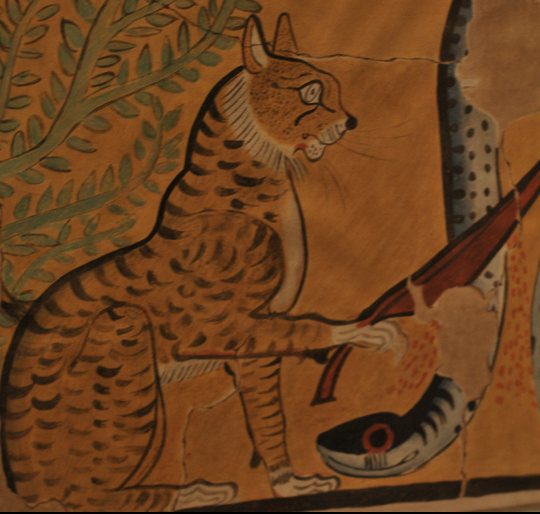

Bast's consort Atum. A solar deity representing the setting sun. Demiurge who created the world, born from the original chaos of Nuna, along with the first hill of land Ben Ben. He exuded the nine energies-deities that created the world.
But over time Atum was displaced from the first position, in ancient mythology, and the pantheon was headed by the sun god Ra.
The totemic appearance of Atum is that of a mongoose. Interestingly, a Sumerian saying has survived, "A cat is valued for what it is a cat, and a mongoose for what it does."
The second appearance of Atum is the serpent. In the Book of the Dead he tells Osiris that he will destroy the world by returning it to the original water element.
The son of the goddess was Mahem (Mahesh, Misis), the lion-headed god of storm and war. The first symbol of his name is the same as in the name of the goddess of justice Maat. Therefore he is also the defender of the innocent. And in full his name is translated as: "He who is true beside her." On the one hand he commands bad weather, on the other he is a protector from spoil, misfortune, the evil eye, deceit. His temple was also located in Bubastis.
Bast's connection with the other Goddesses.
Bast and Maat. Justice.
The goddess Bast is directly related to the other Egyptian goddesses.
The fur in her ears is shaped like the feathers of Maat, the goddess of laws of the foundation of our world, and the hieroglyph feather is included in the inscription of her cat's name. Therefore, Bast hears any injustice and reacts to violation of balance and justice.
Here we are interested in a tale describing the story of a 13th century B.C. prince named Setna who steals a forbidden book from a tomb. On his way out of the tomb he is met by a beautiful girl named Tabuba, who calls herself the daughter of the priest Bast. In exchange for sex with her, Setna must sign over all his possessions to her and kill his children from a previous marriage. The prince agrees and when he embraces the priest's daughter Bast, he suddenly finds himself outside naked and with his penis in a clay pot. He realizes that this is punishment from the Goddess for the stolen book. Pharaoh passes by at this moment and tells Setna that his children are alive and that this was an obsession as punishment for stealing the ancient scroll.
This story also warned men against mistreating women and what can happen to them if they are not respectful of the female sex. After all, you never know who is in front of you, the woman or the Goddess. This side of Bast is an extension of the energies of the goddess of justice Maat.
Bast and Sekhmet. Healing and protection.
The original, most ancient appearance of the Goddess is the formidable lioness Sekhmet-Malfet, who was described as The-powerful-female-one. Who on the one hand strikes people for disrespecting the gods with terrible arrows of disease, but if you please her, she is a great healer. And the chief priest of Per-Bast bore the name Ur-Sunu, that is, the Great Healer.
In order to pacify the furious Sekhmet she is served beer with hematite powder. The drink takes on a blood-red color. The goddess drinks the "bloody" offering and falls asleep. This is why one of the names of the festival in honor of the goddess is "The Night of Intoxication". And red beer is the main drink on the altar.
To protect against Egyptian enemies, there were special ovens in the sanctuary for rituals to destroy the enemies of the country of Kemt.
Bast and Renepet. Lord of Time.
Like Renepet, whose name denotes the year, Sekhmet, and through her, Bast is linked to the annual cycle.
Bast and Hathor. Love and music.
Another legend, more recent, of the Goddess's appeasement is associated with the sacred lake on the island of Abaton, where the wrathful Sekhmet enters and from there the graceful Bast emerges and transforms into Hathor. The sistrum in the hands of Bast clearly indicates her direct connection with the Goddess of Love.
Bast and Isis.
Isis is a manifestation of the "ba" (personal qualities) of the sun god Ra. Isis's "ba" is Bast. And the "ba" of Bast is the cat.
One of the names of Isis sounds like Bast ba'Aset - the soul of Ba Isis.
So Bast (and with her the cat) is directly related to Isis' magic. She sees in the dark ages and transmits magical power to the crown of the Egyptian pharaohs. One of her names is Great Charami.
Bast and Mut. Great Mother of the Gods.
Lion (cat) appearance also takes the mother of the gods Mut.
If to accept that ancient Egyptians had a concept that everything is generated by one initial principle of creation (Primordial Deity) and their deities' archetypes could take various forms, then the Goddess Bastet, who is not a woman yet, but already not a fearsome lioness, definitely became an integral energy of the circle of female totems of ancient country Kemt very early. And by the beginning of the first millennium having passed a way from a formidable lioness to a peaceful cat she joined the circle of totemic goddesses: Cow - Snake - Lioness - Cat - Woman. And these forms influenced the further development of all human civilization.
Meditation "Awakening of qualities of peaceful Bast".
Meditation "Awakening the qualities of Bast" is designed primarily for healing and the opportunity to discover such qualities as grace, flexibility, strength of life, self-sufficiency.
In the meditation, your imagination will take you to ancient Egypt to the temple of the Goddess Bast. At first you will wash yourself in the house for ritual ablutions. Purify your body with a sacred rubbing of "natron" or "natron" based on soda and herbs. By the way, one of the meanings of this word is "god". Then you enter the temple through the sacred gate and enter the first hall, where there are columns like date palms. This is the place where all worldly thoughts are let go and the purpose with which you go into the sanctuary is formulated.
As you enter the second courtyard of the temple, you will meet the cat healers who will heal your physical body and soul.
This is where your cat guide will appear. She will guide you to the third courtyard of the temple. It is called "Akhbit - the eternal marshes" with papyrus-shaped columns. Here the magic of rejuvenation and foretelling will take place.
Then you will go to the fourth courtyard of the temple "Ringing Goddess", where you will sing, dance, recite poetry or just move clapping your hands to the real! the music of ancient Egypt.
"Sound is life," said the people of the country of Kemt. It is an offering with the energies of the Goddess. This is your gift to her.
From here you can see through the doorway to the fifth space of the temple, where the statue of the Goddess and her rook stand for solemn exits. But this is a place where only priests may enter and only for ritual.
After the offering dance, your guide cat will take you to the room for "prophetic dreams," where the goddess can come to you in a dream and you can get an answer to your questions.
Please note, if you ask the deity for something, then it is obligatory to feed the cats for 7 days. In any case, after performing this meditation, it is a good idea to feed the street cats or make a charitable donation to some animal shelter.
When you emerge from the prophetic dream, you return fully and completely to the here and now, to ordinary reality, completing your meditation-visualization.
I am often asked when it is best to perform a particular meditation.
I prefer to perform meditations on the 22nd lunar day, when we can learn from the subconscious mind, through symbols, the secrets hidden in the depths of the subconscious mind.
And for Bast, we can perform a meditation, a creative visualization, closer to April 15. After all, it was on this day that the ancient Egyptians celebrated her holiday.
Have a successful practice.
Copyright©Egeney McQueen 2018.
You can purchase the Bast Awakening meditation by writing to Eugenie McQueen on Facebook.
You can order the amulet "Moon cat" you can write in Facebook to the jeweler Elena Boris.
Literature :
1.Jennifer Houser Wegner, PhD Associate Curator, Egyptian Section, Penn Museum. Cats, lions and the fabulous felines of ancient Egypt.
2.Joshua J. Mark .Cats in the Ancient World
3.Lecture by V. Solkin The Cat of the Pharaohs.
4.J.-D. Vigne, J. Guilaine, K. Debue, L. Haye, P. Gérard. Early Taming of the Cat in Cyprus.
5.Andy Warycka and Nancy J Price.When were cats first kept as pets?
6.Episodes of 'Cats Through the Ages', Dr John Bradshaw, author of 'Cat Sense'.
7.Jaromir Malek, The Cat in Ancient Egypt, revised edition. London: British Museum Press, 2006.
In Eugenie McQueen's Lunar Mystery School TELEGRAM group, you can participate in online practices and receive guidance from Eugenie herself.
To join the group, follow this link.
If you have trouble joining the group through the link, email Eugenie McQueen on Facebook.
Reviews of Eugenie McQueen's practices and meditations.
Recommendations for the practices of the summer eclipse corridor June-July 2020.
The magic of the goddesses of ancient Egypt.
Cosmetic recipes of ancient Egyptian women.
Where did the triad of blonde, brunette and redhead come from.
Women's practices of the full moons.
Meditations of the 8 Goddesses of the Wheel of the Year.
Useful books for women practitioners.
Diaries of a Witch. The Sands of Time. A novel about Egyptian women's magic.
Share on social networks
Religious festivals.
The Egyptians revered Bastet, if not for her help with procreation, then at least for the extra seven days of rest. That was how many times a year festivals were held in honor of this goddess. The number of pilgrims flocked to her temples, offering sacrifices to her patroness and offering prayers to her.
In the spring, it was usually remembered that Bastet was the patroness of fertility and crops. Therefore her statue was taken out of the main temple, placed in a reed boat and carried along the banks of the Nile from the mouth to the source. It was believed that this measure would help keep fields and buildings from flooding for too long.
The great patroness
Bastet gave warmth and light and warded off evil spirits, patronized music and dancing, and rewarded intuition and imagination. She was believed to helped childless couples create a large family..
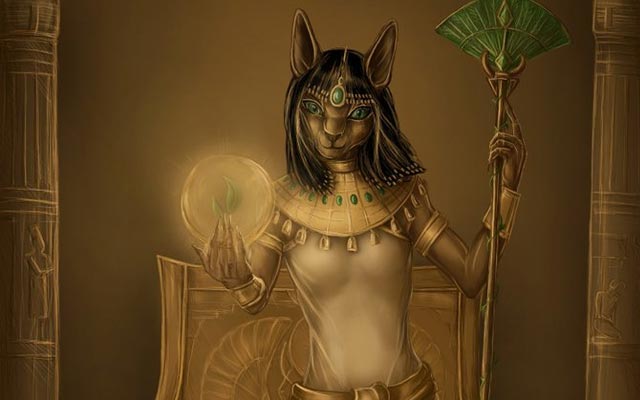

She was prayed to by spouses who dreamed of having many children, and by women who wished to preserve their beauty and to prolong their youth. In April the fertility festival was celebrated, and people marched through the streets in festive procession, singing to Bast and praying to her for a good harvest.
The goddess also found her significance in medicine. It was customary for the dwellings of healers to be painted with black cats, which were considered a symbol of medicine.
Healers painted the goddess next to the bed of the patient, so that he could recover as quickly as possible.
Cat in Legislative Acts
The sacred animal of the goddess Bastet in ancient Egypt was protected by many laws. First of all, for the unintentional or intentional killing of a cat, the perpetrator faced a painful execution. In addition, fearing that the favor of Bastet would not leave Egypt, the laws forbade the export of cats from the territory of the country. Whoever ignored this law had to pay a high fine and also pay penance to the goddess.
However, the Egyptians themselves were afraid to part with the cat. The pirates, who were abundant along the Egyptian coast, knew about this and quickly figured out how they could make money. They kidnapped the cats and then demanded a huge ransom from their owners. The owners were prepared to pay any amount so that the cat would return home and they would not be accused of smuggling.
Picture


Very interesting is also how the goddess Bastet was depicted. It is a woman either in the guise of a cat or with a cat's head. However, in ancient Egypt you will not find images of tame, domestic cats. They were depicted only as wild animals, such as the cat of Heliopolis. And only in the second century A.D. was this animal firmly reunited with people and domesticated. Since then, cats were worshipped, guarded and loved everywhere. After the death of these animals were embalmed, sometimes even deified. Interesting will seem the fact that the cat is considered a sacred animal of the god of the sun. Cats were seen as his embodiment, and the eyes of these animals, according to the Egyptians, radiated sunlight.
Bubastis .
As is clear from the name, this city was the center of veneration of cats and the Egyptian goddess Bastet. According to photos taken by archaeologists at the ruins of this cult center, it is clear that the cat cult reached its highest point here.
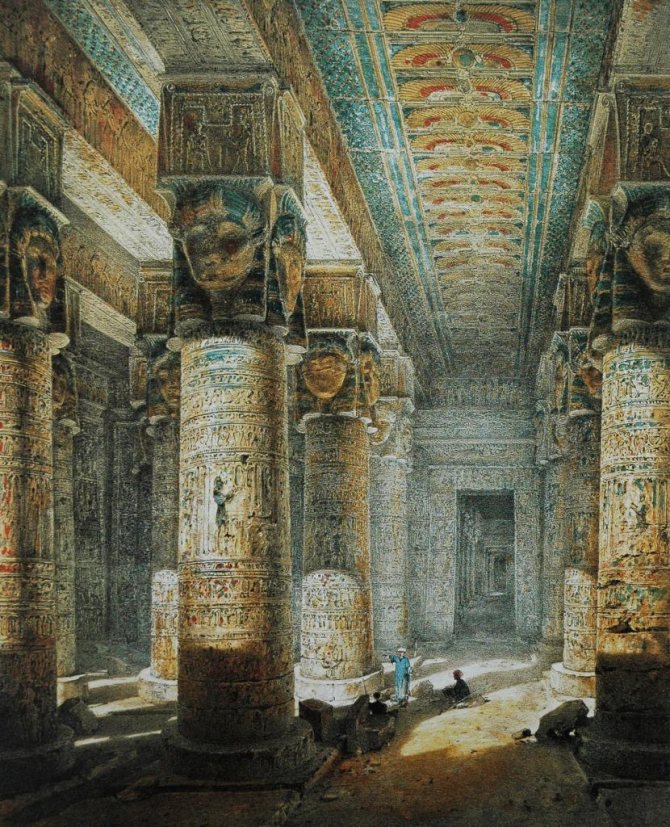

It takes place in the first millennium BC, when a Libyan by birth - Pharaoh Sheshonk moves the capital of Egypt to Bubastis. The cats clearly liked life in the capital: according to Herodotus, who personally visited the city, there were several thousand whiskers and tails in the huge temple, which were looked after with special care and immense respect by the priests. In the main hall of this feline paradise was a statue of Bastet one meter high.
Description and origin
The dawn of the worship of the goddess originated around the fifth to eighth centuries B.C. Her biography originated in the ancient Egyptian city of Bubastis. Bastet's parents were Ra (the Sun) and Hathor (the Moon), her brother was Khonsu (patron of healers) and her sister was Nut (the lord of the sky).
The goddess had two forms:
- Catwoman (Bast), the protector and benefactress of the female race.
- The lion-woman (Sekhmet) - the foremother of conflicts. With her hot breath Sekhmet caused drought and turmoil. She was cried out to in moments of despair, making blood sacrifices. Her parents were Osiris and Isis.
Bastet's husband was the god Ptah. He patronized the arts and crafts. Mahesh was their son. He was the patron saint of the Egyptian pharaohs.
Egyptian legend.
There is a myth (story) about a goddess and a butterfly that goes briefly like this. Bast was resting one evening, and a butterfly flew into her bedchamber to distract her from her thoughts of the eternal. The winged guest circled near the flames, flew up to Bast, and returned to the fire. The butterfly disturbed her concentration, and there was no way to chase it awaybecause the goddess was afraid of getting burned. She called to Horus (the god of dying and regenerating nature) that he drove away the intrusive guest.
But Horus would not drive the insect away. Instead, he asked Bast whether the moth was beautiful or not. The goddess looked closely at her guest, who flew dangerously close to the fire, and saw the scorch marks on her wings. But despite the burns, the butterfly was still circling near the flames.
Bastet told Horus that she was more beautiful because she was a goddess, and that a butterfly was just an insect that would die not today, but tomorrow. That her life is a moment, and it doesn't matter how beautiful she is.
Gore looked thoughtfully at Bast and said that he wanted to know the truth about the life of a moth. The goddess, looking at him, also closed her eyes and thought. She suddenly realized that she should have known everything about the life and feelings of the moth. She felt ashamed of her indifference. She asked Horus if he knew the truth. He answered that he understood everything, but he did not go into details and left.
The goddess ran after him, begging for an answer. Gore turned around and asked why it was so important to her. Bast said she would be miserable if she didn't know the truth. God smiled and said that the truth had already been revealed: it was her peace.
And at that moment the butterfly flapped her wings one last time, and fell into the fire. A few sparks flew upward and disappeared with the moth.
Cat worship
Cats have been considered mystical creatures by all nations since ancient times. People intuitively understood that some of the habits of these animals are beyond the human mind. The Egyptians, after the domestication of graceful cats, elevated them to the first place in gratitude for their help in the fight against rodents and preservation of crops.
Every year in Egypt, celebrations were held in honor of the goddess. They were accompanied by festive processions with dances and songs. During these days, the inhabitants of Bubastis drank more beer than all the inhabitants of the country in a whole year.
Egyptians buried cats with honors in specially designated places - necropolises. People embalmed their bodies and placed them in a sarcophagus. All family members took part in the funeral procession. The burial ceremony was performed by priests. Toys and treats were placed in the grave with the animal. Even pharaohs honored cats by participating in sacrifices.
If anyone dared to kill an animal, they were put to death. And when a cat died in the family, the owners would shave their eyebrows as a sign of mourning. The driver, whose carriage ran over this sacred animal, was stoned in public.
Funeral ceremonies
Archaeological research has shown that not only during life, but also after death the sacred animals of the goddess Bastet were venerated. Photos taken at the excavations amazed the world not only by the scope of engineering genius of the Egyptians, capable of erecting luxurious buildings with a minimum of technological means. It turned out that next to the temple of Bastet is a huge feline cemetery.
Mummification was a painstaking and costly undertaking, so only the pharaohs, and some particularly noble nobles, were honored with it. But in Bubastis, cats were also mummified, and no worse than the pharaohs. Animals were rubbed with expensive incense, swaddled with fine cloths, and even had specially made masks placed on their faces. Since a cat is no worse than a pharaoh, it was believed that its soul could return to the dead body, so the graves were placed in the essentials: food, toys and even mummies of mice. In total, during the excavations in 1890, was discovered more than four hundred thousand mummies and skeletons of cats.
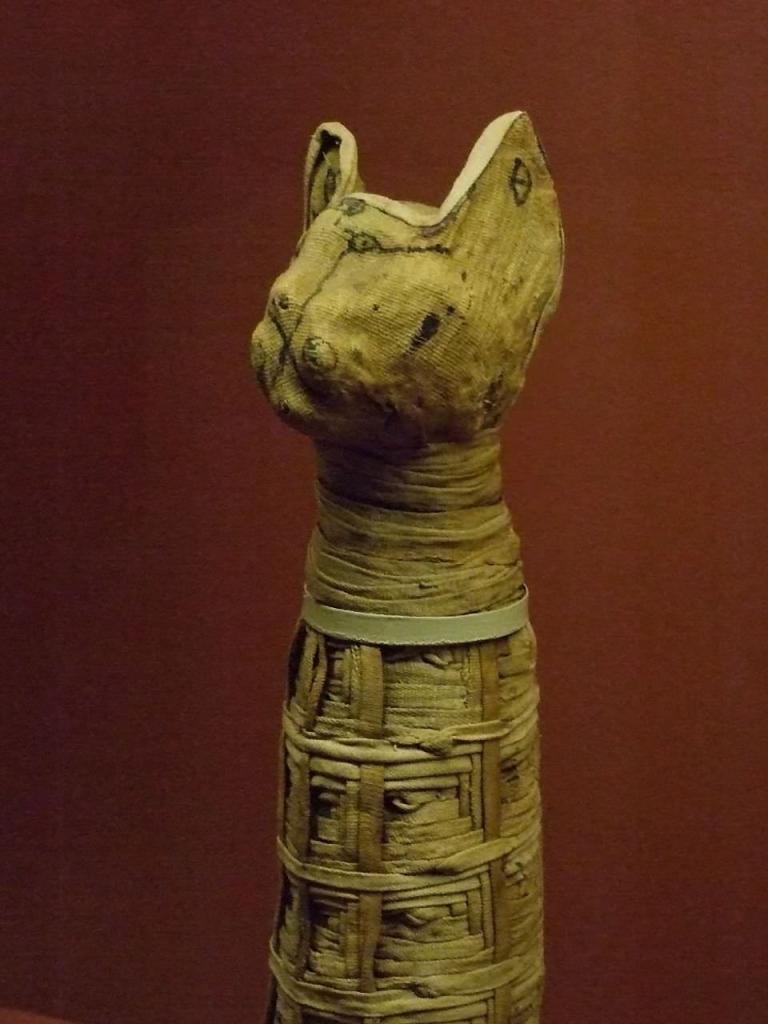

When a cat died, its owners declared mourning. As a sign of this, they shaved off their hair and eyebrows, refused to eat, and even hired special mourners to see the cat off to its last journey. But for inconsolable owners there was a hope that the Sun and the Moon were the eyes of their cat which watched the world from the goddess Bastet's chambers.
About cats
It is also worth mentioning that a statue of the goddess Bastet was always present in almost every home of the Egyptians. She was considered a strong amulet and protector of the home. In addition, it was considered a good sign if there was a live cat in the family. It is worth saying that it was the most important member of the family, sometimes it was even more important and more important than the child. The cat was always fed before the owners sat down at the table, it slept in a specially designated place for it or even a room, which were necessarily decorated.
It was especially important when the cat died. It was a great grief for the family. It was mummified according to all the rules, buried with great honors, food was placed in the sarcophagus so that the cat would not starve in the netherworld, also a mouse, so that it would not be bored there. For a long time after the death of the animal owners still mourn the loss, wearing mourning clothes. It is also worth mentioning that the killing of a cat was considered a great sin and was punishable by law by death. It was also forbidden to take cats out of the country, but traders everywhere did so, creating a certain ritual of honor (thanks to this, cats spread all over the world). However, the love for these animals played a cruel joke on the Egyptians during the war with the Persians. The fact is that the Persian king knew about this love of the Egyptians and ordered his soldiers to tie a cat to each shield. The soldiers simply did not dare to shoot at the sacred animals, and were captured by their opponents with no problem.
The flip side of the cult
As you know, the unattended geese saved Rome, but the revered cats of Egypt ruined it. Goddess Bastet, responsible for fertility and childbearing, was not angered under any circumstances. Perhaps in the subconsciousness there were fragments of old legends about her ability to turn into ruthless Sekhmet. So by the end of the existence of independent Egypt, the veneration of cats had gone beyond all reasonable limits.
The Persians, Egypt's main adversaries, were well aware of this. King Cambyses, fearing that he might be defeated in open battle, ordered that as many cats as possible be captured and tied to their shields. Such abuse of the sacred animal stunned the Egyptians. It was out of the question to fight, because it was possible to accidentally harm the wriggling cat on the shield. The battle was lost, and Egypt became part of the Persian kingdom.
The end of the cult
Under the new power, the veneration of cats became more difficult and the temple at Bubastis fell into disrepair. However, the cult persisted until the establishment of Roman rule. The practical Romans saw nothing special in a cat: at best, an ordinary mouse hunter. However, memories of the former heyday of the cat cult persisted. So sometimes the Romans could play on the religious feelings of the Egyptians if they were not very loyal for some reason. One Roman governor, when confronted with disobedience, ordered that all the black cats that were caught should be caught and killed. This immediately brought the rebellious Egyptians to their senses.
The Cult of the Goddess: Withering
After the Roman government came to the country, the Egyptian cat goddess Bastet became less and less respected and in 390 her cult was forbidden by law. Over time, interest in and respect for this animal subsided, and cats were kept in homes simply as hunters of snakes and mice, which at that time were quite numerous. However, even less fortunate were the cats that made their way to Europe. For their love of walking at night and their glow-in-the-dark eyes, the Catholic Church declared them the spawn of the devil. The black cats, so revered in ancient Egypt, were considered the helpers of witches and the receptacles of the souls of their dead brothers-in-law. Cats were killed, tortured and mocked in every possible way. However, as soon as the Renaissance came, these animals were finally put to rest and interest in them largely subsided. Today, there is no negative attitude to the cats, but so far no one and does not deify them. These animals, as before, live close to people, associated with a huge number of superstitions, to which people are still out of habit cautious. But who knows, maybe again the time will come and cats will be revered, as before, enthroning them on a certain pedestal.
